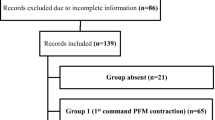Abstract
Introduction and hypothesis
The purpose of this study was to determine pelvic floor muscle (PFM) function in hospitalized elderly women with urinary incontinence (UI).
Methods
A cross-sectional study was performed using data of 704 patients, routinely collected by means of a clinical UI assessment.
Results
Only 25.5% of the patients were able to perform normal PFM contractions (Oxford grading scale score ≥3); 74.5% were unable to contract their PFM or showed weak PFM activity without circular contraction or elevation of the vagina. Vulvovaginal mucosal dystrophy was noted in 84% of the patients. A significant positive correlation of PFM function was found to cognitive status (MMSE score), mobility (Tinetti performance score), and history of previous PFM training; a negative correlation of PFM function was found to patients’ age and vulvovaginal mucosal dystrophy, and no significant correlation to body mass index, parity, or history of hysterectomy.
Conclusions
Targeted clinical UI assessment including digital vaginal palpation should be performed in all incontinent elderly women in order to detect PFM dysfunction and to optimize therapeutic measures.

Similar content being viewed by others
References
DuBeau CE, Kuchel GA, Johnson T et al (2010) Incontinence in the frail elderly: report from the 4th International Consultation. Neurourol Urodyn 29:165–178
Lifford KL, Townsend MK, Curhan GC et al (2008) The epidemiology of urinary incontinence in older women: incidence, progression, and remission. J Am Geriatr Soc 56:1191–1198
Ouslander JG, Johnson TM (1998) Incontinence. In: Hazzard WR, Blass JP, Ettinger WH et al (eds) Principles of geriatric medicine and gerontology, 4th edn. McGraw-Hill, New York, pp 1595–1613
Goode PS, Burgio KL, Richter HE et al (2010) Incontinence in older women. JAMA 303:2172–2181
Thüroff JW, Abrams P, Andersson KE et al (2011) EAU Guidelines on urinary incontinence. Eur Urol 59:387–400
Fung C, Spencer B, Eslami M et al (2007) Quality indicators for the screening and care of urinary incontinence in vulnerable elders. J Am Geriatr Soc 55:443–449
Woodford H, George J (2007) NICE guidelines on urinary incontinence in women. Age Ageing 36:349–350
Messelink B, Benson T, Berghmans et al (2005) Standardisation of terminology of pelvic floor muscle function and dysfunction: report from the pelvic floor clinical assessment group of the international continence society. Neurourol Urodyn 24:374–380
Bo K, Sherburn M (2005) Evaluation of female pelvic-floor muscle function and strength. Phys Ther 85:269–282
Laycock J, Whelan MM, Dumoulin C (2008) Patient assessment. In: Haslam J, Laycock J (eds) Therapeutic management of incontinence and pelvic pain, 2nd edn. Springer, London, pp 57–66
Talasz H, Kofler M, Kalchschmid E, Pretterklieber M, Lechleitner M (2010) Breathing with the pelvic floor? Correlation of pelvic floor muscle function and expiratory flows in healthy young nulliparous women. Int Urogynecol J Pelvic Floor Dysfunct 21:475–481
Lawrence J, Lukacz E, Nager C et al (2008) Prevalence and co-occurrence of pelvic floor disorders in community-dwelling women. Obstet Gynecol 111:678–685
Bo K (2006) Pelvic floor muscle training is effective in treatment of female stress urinary incontinence, but how does it work? Int Urogynecol J 2:76–84
Ashton-Miller JA, Howard D, DeLancey JOL (2001) The functional anatomy of the female pelvic floor and stress continence control system. Scand J Urol Nephrol Suppl 207:1–7
Theofrastus JP, Wyman JF, Bump RC et al (1997) Relationship between urethral and vaginal pressure during pelvic muscle contraction. Neurourol Urodyn 16:553–558
Godec C, Cass AS, Ayala GF (1975) Bladder inhibition with functional electrical stimulation. Urology 6(6):663–666
Dumoulin C, Hay-Smith J (2010) Pelvic floor muscle training versus no treatment, or inactive control treatments, for urinary incontinence in women. Cochrane Database of Systematic Reviews 2010, Issue 1. Art. No.: CD005654
Wagg A, Potter J, Peel P et al (2008) National audit of continence care for older people: management of urinary incontinence. Age Ageing 37:39–44
Tinetti ME (1986) Performance-oriented assessment of mobility problems in elderly patients. J Am Geriatr Soc 34:119–126
Folstein MF, Robins LN, Helzer JE (1983) The mini-mental-state examination. Arch Gen Psychiatry 40:812
Haylen BT, de Ridder D, Freeman RM et al (2010) An International Urogynecological Association (IUGA)/International Continence Society (ICS) joint report on the terminology for female pelvic floor dysfunction. Int Urogynecol J 19:131–135
Bo K, Finckenhagen HB (2001) Vaginal palpation of pelvic floor muscle strength: inter-test reproducibility and comparison between palpation and vaginal squeeze pressure. Acta Obstet Gynecol Scand 80(10):883–887
Slieker-ten Hove MCP, Pool-Goudzwaard AL, Eijkemans MJC, Steegers-Theunissen RPM, Burger CW, Vierhout ME (2009) Face validity and reliability of the first digital assessment scheme of pelvic floor muscle function conform the new standardized terminology of the International Continence Society. Neurourol Urodyn 28(4):295–300
Resnick NM, Elbadawi A, Yalla SV (1995) Age and the lower urinary tract: what is normal? Neurourol Urodyn 14:577–579
Fritsch H (2006) Aging of pelvic floor muscles. In: Carriere B, Feldt CM (eds) The pelvic floor, 2nd edn. Thieme, New York, pp 19–20
MacBride MB, Rhodes DJ, Shuster LT (2010) Vulvovaginal atrophy. Mayo Clin Proc 85:87–94
Leibovitz A, Kaplun V, Saposhnicov N et al (2000) Vulvovaginal examinations in elderly nursing home women residents. Arch Gerontol Geriatr 31:1–4
Harris T (1998) Weight and age: paradoxes and conundrums. In: Hazzard WR, Blass JP, Ettinger WH et al (eds) Principles of geriatric medicine and gerontology, 4th edn. McGraw-Hill, New York, pp 967–972
Sherburn M, Bird M, Carey M, Bø K, Galea MP (2011) Incontinence improves in older women after antensive pelvic floor muscle Ttraining: an assessor-blinded randomized controlled trial. Neurourol Urodyn 30:317–324
Acknowledgments
The authors would like to acknowledge Mira Ljubinkovic, Hochzirl, Austria, for consistently collecting data and assisting the project during the whole study period, and to express their gratitude to Ellen Quirbach, Hochzirl, Austria, for providing editorial help with the manuscript.
Conflicts of interest
None.
Author information
Authors and Affiliations
Corresponding author
Rights and permissions
About this article
Cite this article
Talasz, H., Jansen, S.C., Kofler, M. et al. High prevalence of pelvic floor muscle dysfunction in hospitalized elderly women with urinary incontinence. Int Urogynecol J 23, 1231–1237 (2012). https://doi.org/10.1007/s00192-011-1628-4
Received:
Accepted:
Published:
Issue Date:
DOI: https://doi.org/10.1007/s00192-011-1628-4




